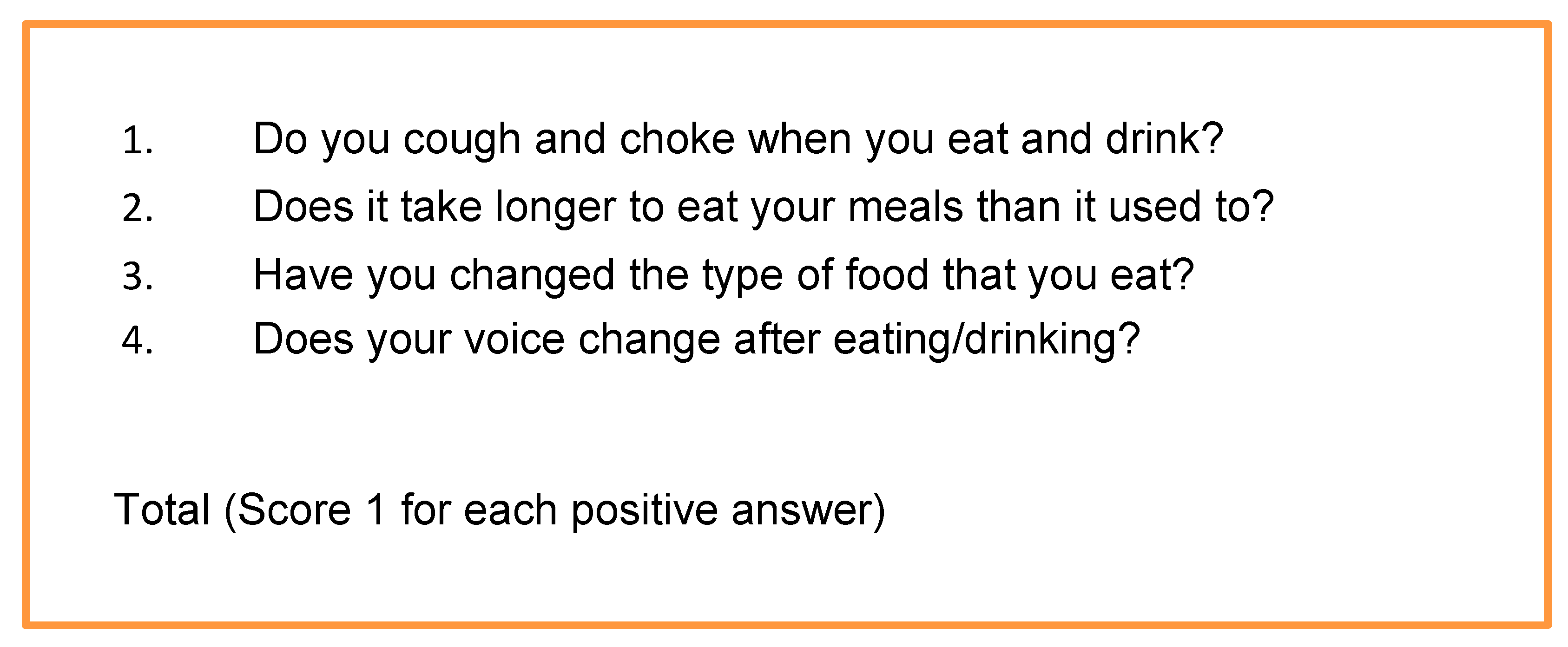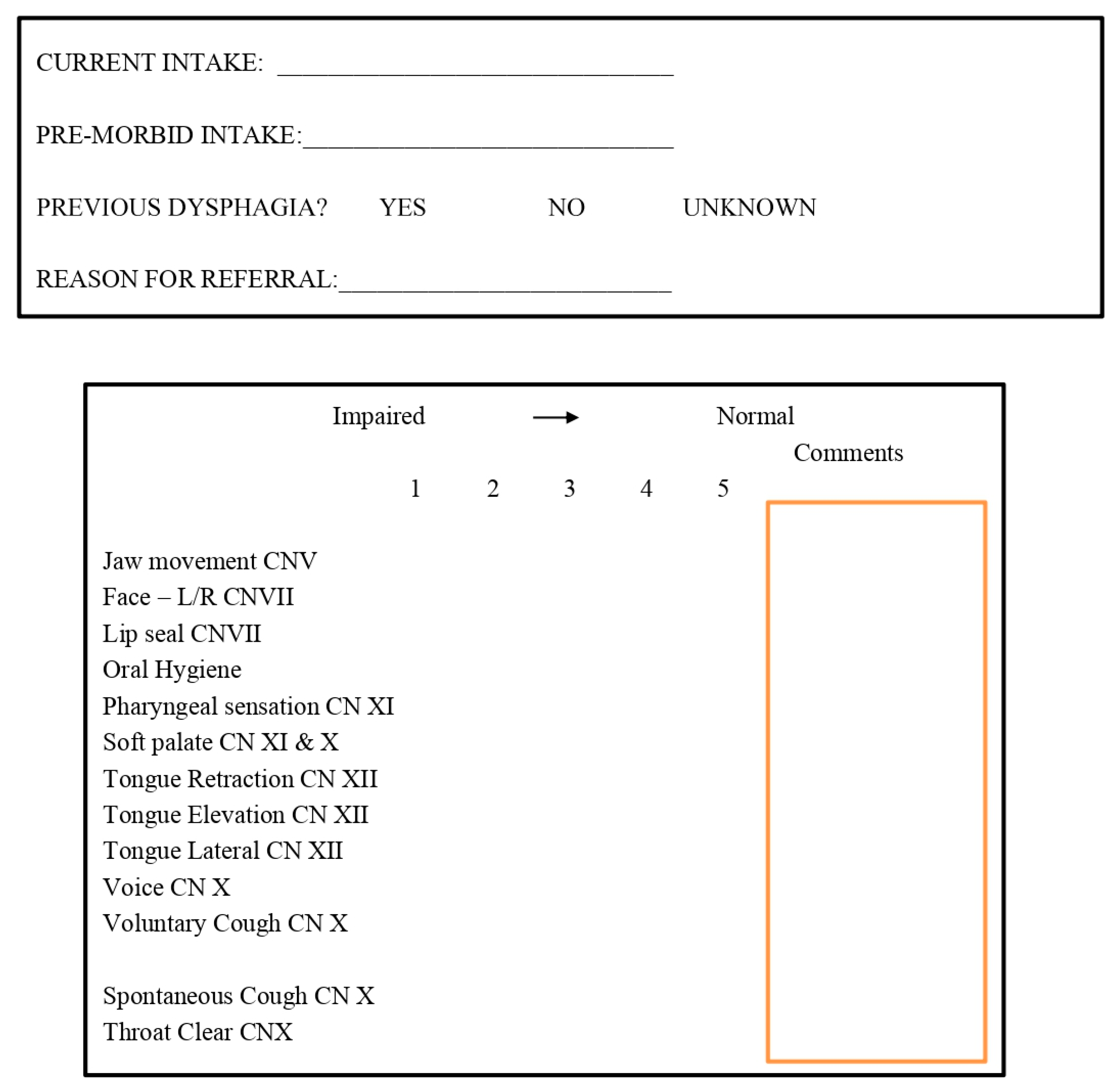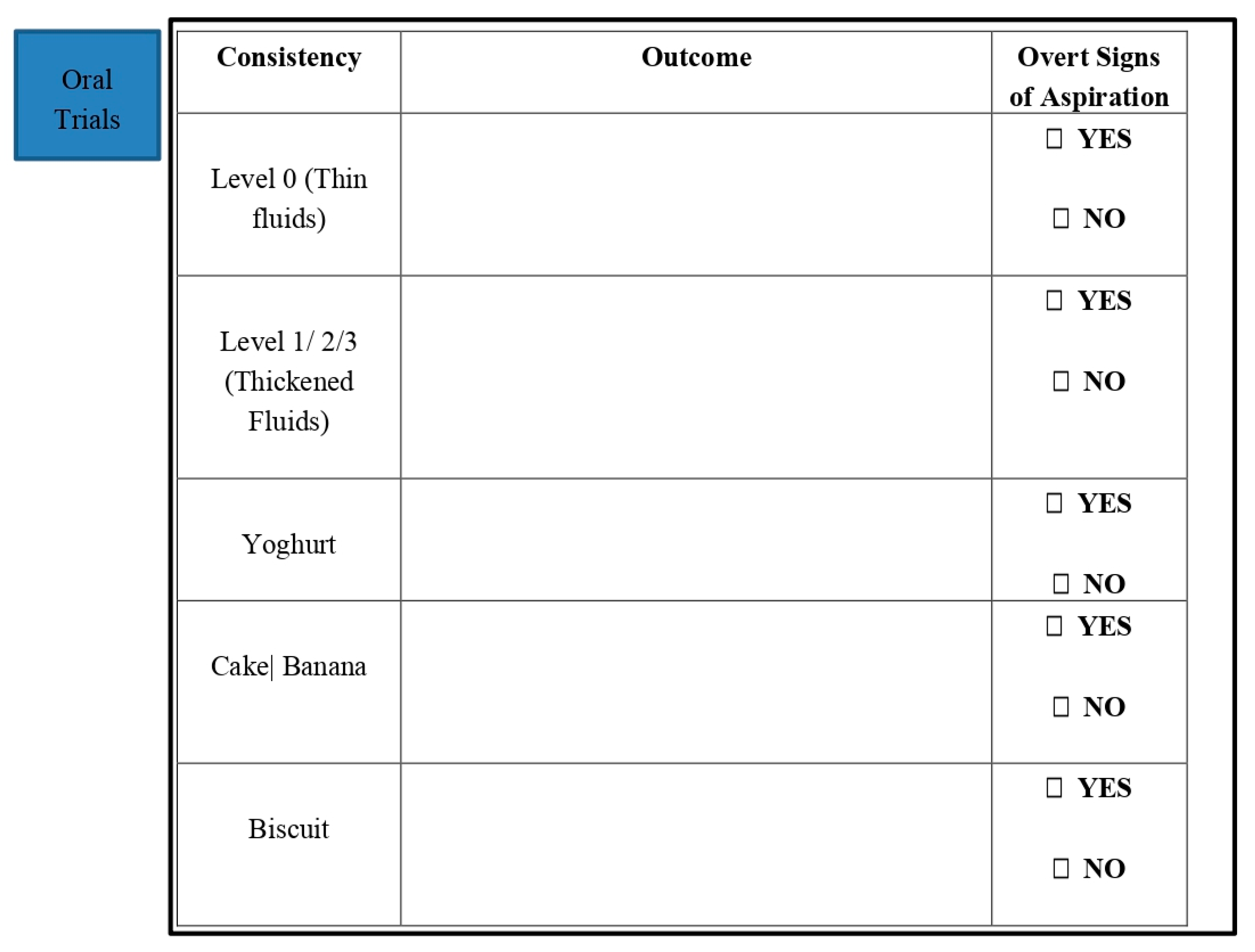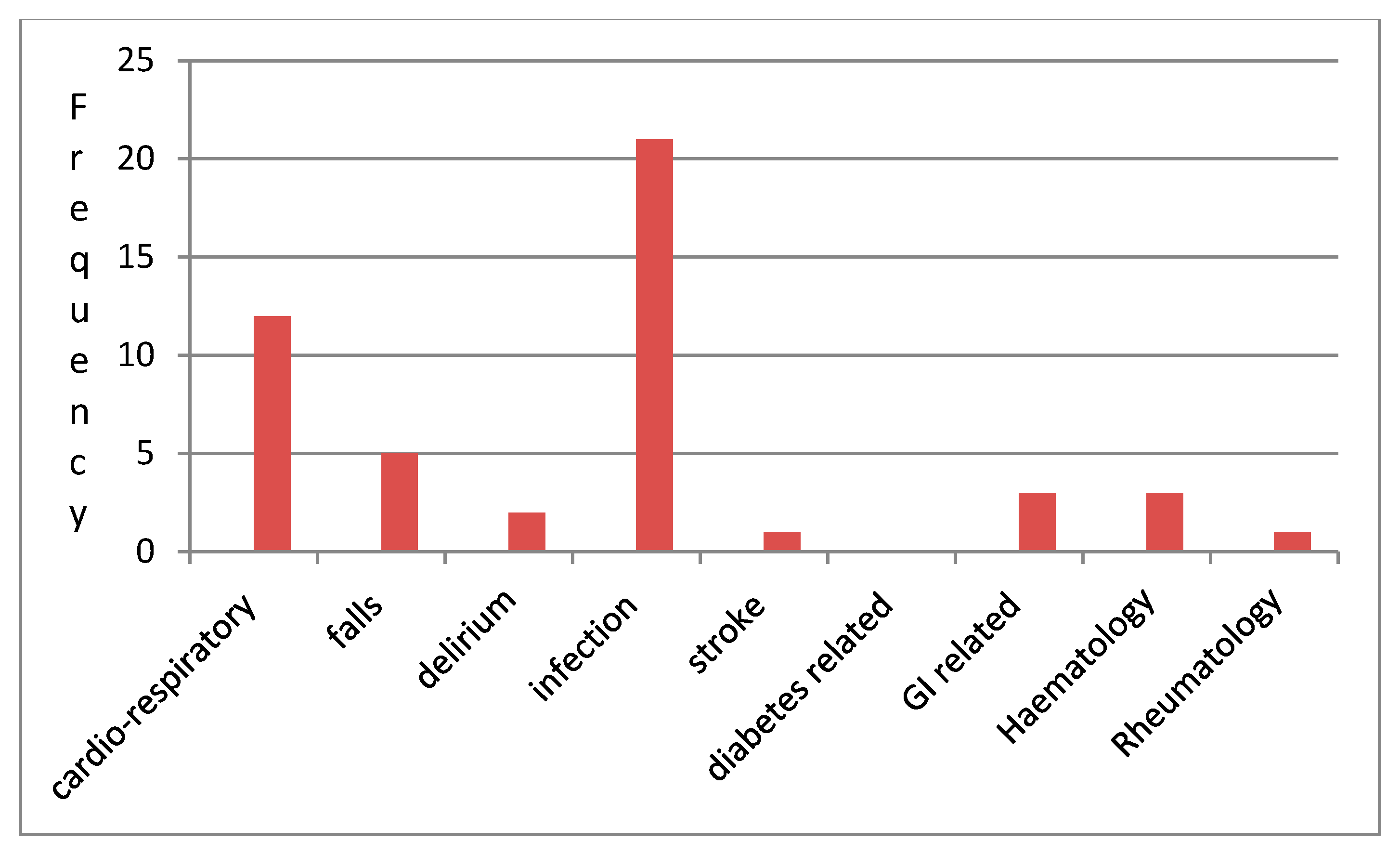A New Simple Screening Tool—4QT: Can It Identify Those with Swallowing Problems? A Pilot Study
Abstract
1. Introduction
2. Methods
2.1. Stage 1
2.1.1. Methodology
2.1.2. Results
2.2. Stage 2
Methodology
3. Results
4. Discussion
5. Limitations
6. Conclusions
7. Future Direction
Author Contributions
Funding
Acknowledgments
Conflicts of Interest
References
- Doty, R.W. Influence of stimulus patter on reflex deglutition. AM. J. Physiol. 1951, 166, 142–158. [Google Scholar] [CrossRef]
- Smithard, D.G. Dysphagia: A geriatric giant? Med. Clin. Rev. 2016, 2, 1–7. [Google Scholar] [CrossRef]
- Wilkins, T.; Gillies, R.A.; Thomas, A.M.; Wagner, P.J. The prevalence of dysphagia in a primary care patients: A HamesNet research network study. J. Am. Board. Fam. Med. 2007, 20, 144–150. [Google Scholar] [CrossRef]
- Chen, P.H.; Golub, J.S.; Hapner, E.R.; Johns, I.I.I.M. Prevalence of perceived dysphagia and quality of life impairment in a geriatric population. Dysphagia 2009, 24, 1–67. [Google Scholar] [CrossRef]
- Chen, X.; Mao, G.; Leng, S.X. Frailty syndrome: An overview. CIA 2014, 9, 433–441. [Google Scholar]
- World Bank Statistics. Available online: https://data.worldbank.org/indicator/SP.POP.65UP.TO.ZS?view=chart (accessed on 9 December 2019).
- Eurostats. European Health Information Gateway European Mortality Database. Available online: https://gateway.euro.who.int/en/datasets/european-mortality-database/#population-and-icd-used (accessed on 9 December 2019).
- Phu, S.; Boersma, D.; Duque, G. Exercise and sarcopenia. J. Clin. Densitom. 2015, 18, 488–492. [Google Scholar] [CrossRef] [PubMed]
- Herr, M.; Robine, J.M.; Pinot, J.; Arvieu, J.J.; Ankri, J. Polypharmacy and frailty: Prevalence, relationship, and impact on mortality in a French sample of 2350 old people. Pharmacoepidemiol. Drug Saf. 2015, 24, 637–646. [Google Scholar] [CrossRef] [PubMed]
- Baijens, L.W.J.; Clave, P.; Cras, P.; Ekberg, O.; Forster, A.; Kolb, G.F.; Leners, J.C.; Masiero, S.; Mateos-Nozal, J.; Ortega, O.; et al. European Society for Swallowing Disorders—European Union Geriatric Medicine Society white paper: Oropharyngeal dysphagia as a geriatric syndrome. CIA 2016, 11, 1403–1428. [Google Scholar] [CrossRef] [PubMed]
- Carrion, S.; Roca, M.; Costa, A.; Arreola, V.; Ortega, O.; Palomera, E.; Serra-Pratt, M.; Cabre, M.; Clave, P. Nutritional status of older people with oropharyngeal dysphagia in a chronic vs acute clinical situation. Clin. Nutr. 2017, 36, 1110–1116. [Google Scholar] [CrossRef] [PubMed]
- González-Fernández, M.; Ottenstein, L.; Atanelov, L.; Christian, A.B. Dysphagia after Stroke: An Overview. Curr. Phys. Med. Rehabil. Rep. 2013, 1, 187–196. [Google Scholar] [CrossRef] [PubMed]
- Smith, E.E.; Kent, D.M.; Bulsara, K.R.; Leung, L.Y.; Lichtman, J.H.; Reeves, M.J.; Towfighi, A.; Whiteley, W.N.; Zahuranec, D.B.; American Heart Association Stroke Council. Effect of Dysphagia Screening Strategies on Clinical Outcomes After Stroke: A Systematic Review for the 2018 Guidelines for the Early Management of Patients With Acute Ischemic Stroke. Stroke 2018, 49, e123–e128. [Google Scholar] [PubMed]
- Party, I.S.W. Intercollegiate Stroke Working Party National Clinical Guidelines for Stroke, 4th ed.; Royal College of Physicians: London, UK, 2012. [Google Scholar]
- Bray, B.D.; Smith, C.J.; Cloud, G.C.; Enderby, P.; James, M.; Paley, L.; Tyrrel, P.; Rudd, A.G. The association between delays in screening for and assessing dysphagia after acute stroke, and the risk of stroke associated pneumonia. Neurol. Neurosurg. Psychiatry 2017, 88, 25–30. [Google Scholar] [CrossRef] [PubMed]
- Smithard, D.; Westmark, S.; Melgaard, D. Evaluation of the prevalence of screening for dysphagia among older people admitted to medical services—An international survey. Geriatrics 2019, 3, 1–8. [Google Scholar] [CrossRef]
- National Clinical Guideline for stroke. Intercollegiate Stroke Working Party, 5th ed.; Royal College of Physicians: London, UK, 2016. [Google Scholar]
- Reddy, M.; Smithard, D.G.; Spriggs, D. No gag, no food. Age Ageing 2003, 32, 674. [Google Scholar]
- Belafsky, P.C.; Mouadeb, D.A.; Rees, C.J.; Pryor, J.C.; Postma, G.N.; Allen, J.; Leonard, R.J. Validity and reliability of the Eating assessment tool (EAT-10). Ann. Otol. Rhinol. Laryngol. 2008, 117, 919–924. [Google Scholar] [CrossRef]
- Etges, C.L.; Schreen, B.; Gomes, E.; Barbosa, L.D.B. Screening tools for dysphagia: A systematic review. CoDAS 2014, 26, 343–349. [Google Scholar] [CrossRef]
- Smithard, D.G.; O’Neill, P.A.; Park, C.; Morris, J.; Wyatt, R.; England, R.; Martin, D.F. Complications and outcome following acute stroke: Does dysphagia matter? Stroke 1996, 27, 1200–1204. [Google Scholar] [CrossRef]
- Park, Y.H.; Bang, H.L.; Han, H.R.; Chang, H.K. Dysphagia screening measures for use in nursing homes: A systematic review Korean. Acad. Nurs. 2015, 45, 1–13. [Google Scholar] [CrossRef]
- Jiang, J.L.; Fu, A.Y.; Wang, W.H.; Ma, Y.C. Validity and reliability of swallowing screening tools used by nurses for dysphagia: A systematic review. Tzu Chi Med. J. 2016, 28, 41–48. [Google Scholar] [CrossRef]
- Schrock, J.W.; Lou, L.; Ball, B.A.W.; Van Etten, J. The use of an emergency department dysphagia screen is associated with decreased pneumonia in acute strokes. Am. J. Emerg. Med. 2018, 36, 2152–2154. [Google Scholar] [CrossRef]
- Rockwood, K.; Song, X.; MacKnight, C.; Bergman, H.; Hogan, D.B.; McDowell, I.; Mitnitski, A. A global clinical measure of fitness and frailty in elderly people. Can. Med. Assoc. J. 2005, 30, 489–495. [Google Scholar] [CrossRef]
- Burgoa, R.; Sarto, B.; Segurola, H.; Romagosa, A.; Puiggros, C.; Vazquez, C.; Cardenas, G.; Barcons, N. Translation and validation of the EAT-10 (Eating Assessment Tool-10) for the screening of dysphagia. Nutr. Hosp. 2012, 27, 2048–2054. [Google Scholar]
- Bloem, B.R.; Lagaay, A.M.; van Beck, W.; Haan, J.; Roos, R.A.; Wintzen, A.R. Prevalence of subjective dysphagia in community residents aged over 87. Br. Med. J. 1990, 300, 721–722. [Google Scholar] [CrossRef] [PubMed]
- Cichero, J.A.Y. Age-related changes to eating and swallowing impact frailty: Aspiration, choking risk, modified food texture and autonomy of choice. Geriatrics 2018, 3, 69. [Google Scholar] [CrossRef] [PubMed]
- Van der Maarl-Weinrink, C. Dysphagia and Poor Oral Health: Significant Risk Factors of Aspiration Pneumonia in Frail Older People. Ph.D. Thesis, Radboud University, Nijmegen, The Netherlands, 2016. [Google Scholar]
- Uhm, K.E.; Kim, M.; Lee, Y.M.; Kim, B.R.; Kim, Y.S.; Choi, J.; Han, S.H.; Kim, H.J.; Yoo, K.H.; Lee, J. The easy dysphagia symptom questionnaire for older adults. Eur. Geriatr. Med. 2019, 10, 47–52. [Google Scholar] [CrossRef]
- Schrock, J.W.; Bernstein, J.; Glasenapp, M.; Hanna, J. A novel emergency department dysphagia screen for patients presenting with acute stroke. Acad. Emerg. Med. 2011, 18, 584–589. [Google Scholar] [CrossRef] [PubMed]
- Teuschi, Y.; Trapl, M.; Ratajczak, P.; Matz, K.; Dachenhausen Brainin, M. Systematic dysphagia screening and dietary modifications to reduce stroke-associated pneumonia rates in a stroke unit. PLoS ONE 2018, 13, e0192142. [Google Scholar] [CrossRef]




| Swallow Screen/Assessment | Reference |
|---|---|
| VVST: Volume Viscosity Swallowing Test | Clave P, Arreola V, Romea M, Medina L, Palomera E, Serra-Prat M. Clin Nutr 2008; 27:806–815. |
| TOR-BSST (Toronto Bedside Swallowing Screening Test) | Martino R, Silver F, Teasell, Bayley M. Nicholson G, Streiner DL, Diament NE. The Toronto bedside Swallowing screening test (TOR-BSST) Stroke 2009; 40:555–561. |
| 3-oz WST: 3-oz Water Swallow Test | DePippo KL, Holas MA, Reding ML. Arch Neurol 1992; 49:1259–1261. |
| Cough test | Sato M, Tohara H, Iida T, Wada S, Inoue M, Ueda K. Simplified cough test for screening silent aspiration. Arch Phys Med and Rehabilitation 2012; 93:1982–1986 |
| BDST (Burke Dysphagia Screening Test) | DePippo KL, Holas MA, Reding MJ. Arch Phys Med Rehabil 1994;75:1284–1286 |
| BSA: Bedside Swallowing Assessment | Smithard DG, O’Neill PA, Park C, England R, Renwick DS, Wyatt R, Morris J, Martin DF. Age and Ageing 1998; 27:99–106. |
| Oximetry: Oximetry | Sherman B, Niseboum JM, Jesberger BL, Morrow CA, Jesberger JA. Dysphagia 1999; 14:152–156. |
| PAC-SAC: Prefeeding assessment checklist-Swallowing assessment checklist | Shanley C. J Geront Nursing 2000; 26:35–48 |
| TWST: Timed Water Swallowing Test | Nathadwarawala KM, Nicklin J, Wiles CM. JNNP 19992; 55:822–825 |
| SBST: Simple Bedside Swallowing Test | Sitoh YY, Lee A, Phua SY, Lieu PK, Chan SP. Singapore Med J 2000; 41:376–381 |
| BSA+O2 saturation: Combination of BSA and Oxygen Saturation Monitoring | Smith HA, Lee SH, O’Neill PA, Connolly MJ. Age and Ageing 2000; 29:495–499 |
| DSQ: Dysphagia Screening Questionnaire | Kawashima k, Motohashi Y, Fujishima I. Dysphagia 2004; 19:266–271. |
| GUSS: Gugging Swallowing Screen | Trapl M, Enderle P, Nowotny M, Teuschi Y, Matz K, Dachenhausen A, Brainin M. Stroke 2007; 38:2948–2952 |
| WSD: Westergen’s Screening for dysphagia | Westergen A, Hallberg IR, Ohlsson O. Scand J Caring Sci 1999; 13:274–282 |
| STS-SPT: Simple Two-Step Swallowing Provocation Test | Teramoto S, Matsuse T, Fukuchi Y, Ouchi Y. Lancet 1999; 353;1243 |
| MASA: Mann Assessment of Swallowing Ability | MASA: The Mann Assessment of Swallowing Ability. Mann G. Singular 2002. |
| SSA: Standardized Swallowing Assessment | Perry L. J Clin Nurs 2001; 10:463–473 |
| CFS-D: Clinical Functional Scale for Dysphagia | Paik Nj, Soo KI, Hwan K, Oh BM, Han TR. J Korean Acad Rehab Med. 2005; 29:43–49. |
| Massey BSS: The Massey Bedside Swallowing Screen | Massey R, Jedicka D. J Neurosci Nurs 2002; 34:257–260. |
| 3 non-VFG: Three non-VFG Test (Water+food test+ X ray) | Tohara H, Saitoh E, Mays KA, Kuhlemeier K, Palmer JB. Dysphagia 2003; 18:126–134. |
| MISA: McGill Ingestive Skills Assessment | Lambert HC, Gisel EG, Groher ME, Wood-Dauphinee S. Dysphagia 2003; 18:101–113. |
| DRACE: Dysphagia Risk Assessment for the Community Dwelling Elderly | Miura H, Kariyasu M, Yamasaki K, Arai Y. J Oral Rehabil 2007; 34:422–427 |
| SSA with water/pudding: Standardized Swallowing Assessment with water/pudding | Marques CHD, de Rosso AL, Andre C. Topics in Stroke Rehabil 2008; 15:378–383. |
| MWST+cough test: Modified Water Swallowing Test+Cough Test | Wakasugi Y, Tohara H, Hattori F, Motohashi Y, Nakane A, Goto S, Ouchi Y. Dysphagia 2008; 23:364–370. |
| Emergency Dept Dysphagia Screen | Schrock JW Lou L, Ball BAW, Van Etten J. Am J Emerg Med. 2018; 36(12):2152–2154 |
| NDST: Nursing Dysphagia Screening Tool | Bravata DM, Daggett VS, Woodward –Hagg H, Damush TM, Plue L, Russell S, Allen G, Williams LS, Hareziak J, Chumbler NR. J Rehabil Res Dev 2009; 46:1127–1134 |
| MEOF-II: Minimal Eating Observation Form II | Westergren A, Lindholm C, Mattsson A, Ulander K. J Nutr Health Aging 2009; 13:6–12 |
| ASDS: Acute -Stroke Dysphagia Screen | Edmiaston J, Connor LT, Loehr L, Nassief A. Am J Crit Care 2010; 19:357–364 |
| MMASA: Modified Mann Assessment of Swallowing Ability | Antonios N, Carnaby-Mann G, Crary M, Miller L, Hubbard H, Hood K, Sambandam R, Xavier A, Silliman S. J Stroke Cerebrovasc Dis. 2010; 19:49–57. |
| 9- indicators: 9-Clinical Indicators of Dysphagia | Boczko F. J Am Med Dir Ass 2006; 7:587–590 |
| Element | Frequency |
|---|---|
| Coughing with swallowing | 24 |
| Choking on swallowing | 23 |
| Voice Change with swallowing | 22 |
| Difficulty Swallowing | 11 |
| Time taken to swallow | 5 |
| Change of diet/food eaten | 6 |
© 2020 by the authors. Licensee MDPI, Basel, Switzerland. This article is an open access article distributed under the terms and conditions of the Creative Commons Attribution (CC BY) license (http://creativecommons.org/licenses/by/4.0/).
Share and Cite
Tsang, K.; Lau, E.S.; Shazra, M.; Eyres, R.; Hansjee, D.; Smithard, D.G. A New Simple Screening Tool—4QT: Can It Identify Those with Swallowing Problems? A Pilot Study. Geriatrics 2020, 5, 11. https://doi.org/10.3390/geriatrics5010011
Tsang K, Lau ES, Shazra M, Eyres R, Hansjee D, Smithard DG. A New Simple Screening Tool—4QT: Can It Identify Those with Swallowing Problems? A Pilot Study. Geriatrics. 2020; 5(1):11. https://doi.org/10.3390/geriatrics5010011
Chicago/Turabian StyleTsang, Karwai, Esther SY Lau, Mariyam Shazra, Ruth Eyres, Dharinee Hansjee, and David G Smithard. 2020. "A New Simple Screening Tool—4QT: Can It Identify Those with Swallowing Problems? A Pilot Study" Geriatrics 5, no. 1: 11. https://doi.org/10.3390/geriatrics5010011
APA StyleTsang, K., Lau, E. S., Shazra, M., Eyres, R., Hansjee, D., & Smithard, D. G. (2020). A New Simple Screening Tool—4QT: Can It Identify Those with Swallowing Problems? A Pilot Study. Geriatrics, 5(1), 11. https://doi.org/10.3390/geriatrics5010011






